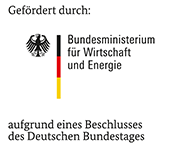16220 N

| Period: | 01.10.2009 - 31.07.2012 |
|---|---|
| Funder: | AiF |
| Project Manager: | Dr. Sigrid Benfer |
| Research Group: | Corrosion |
Introduction
Vessels, reactors, mixers and containers used in the chemical or pharmaceutical industry are often exposed to aggressive chemicals and are therefore protected from corrosion by technical enamels (glass linings). Defects in the enamelling caused, for example, by mechanical treatment are usually repaired by tantalum plugs or tantalum plates. The main disadvantage of this method is the Teflon® sealing required between the enamel and the tantalum, which does not exhibit the same temperature resistance as the enamel layer. Up to now the only alternative is the complete re-enamelling of the whole equipment, which causes high costs through down time and the removal and re-installation of the system.
Therefore, the aim of the project is the development of a repair method for technical enamels which can be applied to the damaged area on-site.
Results
Steel substrates were subjected to different pretreatments to improve the wettability by the repair solution and the adhesion of the sintered glass layer. Reactions with acids, such as HNO3 or H3 PO4 , lead to passivation of the steel surface by oxide or phosphate structures, respectively. These layers reduce the contact angle to water compared with that of the bare steel surface. Particularly suitable is the Pyrosil® -method which leads to the formation of a thin SiO2 adhesion layer.
To prevent the existing enamel layer from cracks the sintering temperature of the repair layer must be as low as possible (< 400 °C). Therefore, chemical nano-technology is used to prepare the repair solutions. Based on liquid metal alkoxides, a colloidal alumina sol and metal salts homogeneous sols with up to seven enamel compounds (Si/B/Al/Co/Ca/Mg/Li) have been prepared.
The sols were brush coated onto plain and partly enamelled steel substrates and sintered in a furnace, by inductive heating or an IR-emitter. Thin crack free layers were obtained on nearly all substrates independent of the investigated sintering conditions (heating rate, heating time and temperature). The thickness of a single layer is very low (<< 1 µ m). The local sintering methods (IR-emitter, inductive heating) allow to produce multiple coating systems in short times. Nevertheless, the thickness of such multiple coatings (20 layers, ≈ 8 µm) is far from that of a technical enamel. Electrochemical Impedance Spectroscopy gives evidence for a protective effect of these layers compared to the bare substrate, but as a result of their chemical composition the layers are not stable in the electrolytic environment.
Corrosion experiments with gel material of different compositions showed that the introduction of ZrO2 leads to a distinct improvement of the chemical stability both in acidic and basic environment.
Future work
Nano- and micropowders of chemical stable materials like zirconia, alpha-alumina or technical enamel will be added to the sol systems to increase the thickness of the sintered layers. These systems will be applied onto the sol gel adhesion layer to build up a filling system which will be sealed by a chemical resistant top coating (sol gel).
Adhesion and chemical durability of all layers has to be investigated.
back

Das IGF-Vorhaben Nr. 16220 N der Forschungsvereinigung DECHEMA e.V., Theodor-Heuss-Allee 25, 60486 Frankfurt am Main wurde über die AiF im Rahmen des Programms zur Förderung der industriellen Gemeinschaftsforschung (IGF) vom Bundesministerium für Wirtschaft und Energie aufgrund eines Beschlusses des Deutschen Bundestages gefördert.
Contact |
| Dr. Sigrid Benfer |
| Telefon: +49 69 / 75 64-382 E-Mai: benfer |
Publications |
| S. Benfer, W. Fürbeth Mitteilungen des Deutschen Emailverbandes e.V. 59 (2011) 74-84 |